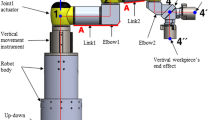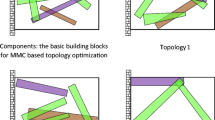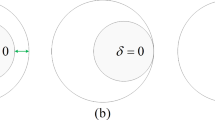Abstract
While the Euler-Savary equation (ESE) has been extensively utilized to locate the center of curvature of the coupler point of planar linkages, comparatively little research has attempted to determine the center of curvature of the disk-cam profile using the ESE. The obstruction of applying the ESE to determine the center of curvature of the disk-cam profile results from the burdensome accessibility of the inflection circle describing the relative motion between the cam and the follower. Therefore, in this paper, we intend to fill the void by introducing Hall’s derivation (Hall in Kinematics and linkage design, Prentice Hall, Hoboken, 1961) for constructing the inflection circle. In addition, the concept of the equivalent linkage is applied to better visualize the conjugate points pairs in the cam mechanism. With the inflection circle obtained from the presented approach, the ESE can advantageously be applied to locate the conjugate point for the center of curvature of the follower’s face, which is the center of curvature of the disk cam profile.

















Similar content being viewed by others
References
Rees-Jones J (1978) Engineering, Mechanisms, Cam Curvature and Interference. 460–463
Terauchi Y, El-Shakery SA (1983) Mechanism and machine theory, A computer-aided method for optimum design of plate cam size avoiding undercutting and separation phenomena—I Design procedure and cycloidal cam design results, 18(2): 157–163
El-Shakery SA, Terauchi Y (1984) Mechanism and machine theory, a computer-aided method for optimum design of plate cam-size avoiding undercutting and separation phenomena—II: Design nomograms, 19(2): 253–241
Cardona S, Zayas EE, Jordi L (2014) Mechanism and machine theory, radius of curvature and sliding velocity in constant-breadth cam mechanisms 81: 181–192
Hidalgo-Martínez M, Sanmiguel-Rojas E, Burgos MA (2014) Design of cams with negative radius follower using Bézier Curves. Mech Mach Theory 82:87–96
Shao Y, Xiang Z, Liu H, Li L (2016) Conceptual design and dimensional synthesis of cam-linkage mechanisms for gait rehabilitation. Mech Mach Theory 104:31–42
Robert L. Norton (2020) Cam Design and Manufacturing Handbook 3rd ed, Norton Associates LLC
Angeles J, Saha SK, Gonzalez-Palacios M, Lopez-Cajun CS (1994) The design optimization of cam mechanisms with oscillating flat-face followers under curvature constraints. ASME J Mech Design 116(1):311–314
Català P, De los Santos MA, Veciana JM, Cardona S (2013) Evaluation of the influence of a planned interference fit on the expected fatigue life of a conjugate cam mechanism—a case study, J Mech Design, 135(8): 081002
Yousuf LS, Hadi NH (2021) Contact Stress Distribution of a Pear Cam Profile with Roller Follower Mechanism, Chinese Journal of Mechanical Engineering, 34, Article number: 24
Matthews JA, Sadeghi F (1996) Kinematics and lubrication of camshaft roller follower mechanisms. Tribol Trans 39(2):425–433
Matthews J, Sadeghi F, Cipra RJ (1996) Radius of curvature and entraining velocity of cam follower mechanisms. Tribol Trans 39(4):899–907
Torabi A, Akbarzadeh S, Salimpour M (2017) Comparison of tribological performance of roller follower and flat follower under mixed elastohydrodynamic lubrication regime, Proceedings of the Institution of Mechanical Engineers. Part J J Eng Tribol 231(8):986–996
Alakhramsing SS, Rooij MD, Schipper DJ, Drogen MV (2018) Lubrication and frictional analysis of cam–roller follower mechanisms, Proceedings of the Institution of Mechanical Engineers, Part J J Eng Tribol, 232(3): 347–363
Yu Q, Lee HP (1996) Curvature optimization of a cam mechanism with a translating flat-faced follower. ASME J Mech Design 118(3):446–449
Flores P (2013) A computational approach for cam size optimization of disc cam-follower mechanisms with translating roller followers. ASME J Mech Robot 5(4):041010
Hamza F, Abderazek H, Lakhdar S, Ferhat D, Yıldız AR (2018) Optimum design of cam-roller follower mechanism using a new evolutionary algorithm. Int J Adv Manuf Technol 99:1267–1282
Dhande SG, Chakraborty J (1976) Curvature analysis of surfaces in higher pair contact—part 1: an analytical investigation. J Manuf Sci Eng 98(2):397–402
Dhande SG, Chakraborty J (1976) Curvature analysis of surfaces in higher pair Contact—Part 2: application to spatial cam mechanisms. J Manuf Sci Eng 98(2):403–409
Litvin FL (1989) Theory of Gearing, NASA Reference Publication 1212
Litvin FL (1994) Gear Geometry and Applied Theory, PTR Prentice-Hall, Englewood Cliffs
Kang YH, Liu JY, Yan HS (1994) Curvature analysis of variable pitch cylindrical cams with conical meshing elements. Math Comput Model 19(5):51–64
Yan HS, Cheng WT (1999) Curvature analysis of spatial cam-follower mechanisms. Mech Mach Theory 34(2):319–339
Yan HS, Cheng WT (1999) Curvature analysis of roller-follower cam mechanisms. Math Comput Model 29(1):69–87
Wu LI, Wu SH, Yan HS (1999) Simplified graphical determination of disk cam curvature. Mech Mach Theory 34:1023–1036
Biswas A, Stevens M, Kinzel GL (2004) A comparison of approximate methods for the analytical determination of profiles for disk cams with roller followers. Mech Mach Theory 39(6):645–656
Di Puccio F, Gabiccini M, Guiggiani M (2006) Generation and curvature analysis of conjugate surfaces via a new approach. Mech Mach Theory 41(4):382–404
Zhou Y, Chen ZC (2015) A new geometric meshing theory for a closed-form vector representation of the face-milled generated gear tooth surface and its curvature analysis. Mech Mach Theory 83(1):91–108
Chen J, Wu J, Tang T (2015) Radius of curvature analysis of oscillating follower cylindrical cam’s expansion pitch curve, Adv Mech Eng, 7(7)
Zhang Y, Ji S, Zhao J (2016) Study on the geometric characteristics of mating surfaces of globoidal cam mechanisms. Mech Mach Theory 100:44–62
Hall AS (1961) Kinematics and linkage design. Prentice Hall, Hoboken
Martin GH (2002) Kinematics and dynamics of machines, 2nd edn. Waveland Pr Inc, Long Grove
Chang WT, Yang DY (2020) A note on equivalent linkages of direct-contact mechanisms, Robotics, 9(2)
McPhate AJ, LR Jr. Daniel (1962) A kinematic analysis of four-bar equivalent mechanisms for plane-motion direct-contact mechanisms. In Proceedings of the Seventh Conference on Mechanisms, West Lafayette, IN, USA, 8–10; pp. 61–65
Chen FY (1970) Algebraic synthesis of a class of four-bar linkages and their equivalent mechanisms. J Mech 6(2):213–230
Wu LI, Chang WT (2005) Analysis of mechanical errors in disc cam mechanisms, proceedings of the institution of mechanical engineers. Part C: J Mech Eng Sci 219(2):209–224
Wang J, Ting KL, Zhao D (2014) Equivalent linkages and dead center positions of planar single-degree-of-freedom complex linkages. ASME J Mech Robotics 7(4):044501
Hartenberg R, Denavit J (1964) Kinematic Synthesis of Linkages. McGraw-Hill, New York
Sandor GN, Erdman AG, Hunt L, Raghavacharyulu E (1982) New complex-number forms of the Euler-Savary Eq. in a computer-oriented treatment of planar path-curvature theory for higher-pair rolling contact. ASME J Mech Design 104(1):227–232
Sandor GN, Xu Y, Weng TC (1990) A graphical method for solving the Euler-Savary equation. Mech Mach Theory 25(2):141–147
Pennock GR, Sankaranarayanan H (2003) Path curvature of a geared seven-bar mechanism. Mech Mach Theory 38(12):1345–1361
Pennock GR, Raje NN (2004) Curvature theory for the double flier eight-bar linkage. Mech Mach Theory 39(7):665–679
Pennock GR, Kinzel EC (2004) Graphical technique to locate the center of curvature of a coupler point trajectory. ASME J Mech Design 126(6):1000–1005
Pennock GR, Kinzel EC (2004) Path curvature of the single flier eight-bar linkage. ASME J Mech Design 126(7):470–477
Jr Uicker JJ, Pennock GR, Shigley JE (2003) Theory of machines and mechanisms, 3rd edn. Oxford University, New York
Waldron KJ, Kinzel GL, Agrawal SK (2016) Kinematics, dynamics, and design of machinery, 3rd edn. Wiley, Hoboken, New Jersey, U.S, pp 246–247
Chen FY (1982) Mechanics and design of cam mechanisms. Pergamon Press, New York
Wu LI (2003) Calculating conjugate cam profiles by vector equations, proceedings of the institution of mechanical engineers. Part C J Mech Eng Sci 217(10):1117–1123
Grubler M (1917) Getriebelehre: eine Theorie des Zwanglaufes und der ebenen Mechanismen. Springer, Berlin
Kutzbach K (1929) Mechanische leitungsverzweigung, ihre gesetze und anwendungen. Maschinenbau, der Betrieb 8:710–716
Paul B (1979) Kinematics and dynamics of planar machinery. Prentice-Hall, Englewood Cliffs, New Jersey, pp 285–289
Dijksman EA (1994) Assembling complete pole configurations for (Over) constrained planar mechanisms. ASME J Mech Design 116(1):215–225
Ye Z, Smith MR (2002) Synthesis of constant-breadth cam mechanisms. Mech Mach Theory 37(9):941–953
Acknowledgements
The authors would like to express their gratitude to Dr. Long-Iong Wu. His inspiring work [25] makes this paper possible. In addition, the authors also wish to acknowledge the support of the department of Mechanical Engineering at National Taiwan University. In addition, the first author offers his grateful thanks to the dedicated referees of this work, whose collective comments form the fundamentals of the research. Most importantly, the Young Scholar Fellowship Program supported by the Ministry of Science and Technology of Taiwan (MOST 110-2636-E-002-023 and 111-2222-E-002-002-MY3) encourages the author to fearlessly devote to his research.
Funding
This research was funded by Ministry of Science and Technology of Taiwan, under grant number MOST 110-2636-E-002-023 and 111-2222-E-002-002-MY3.
Author information
Authors and Affiliations
Corresponding author
Ethics declarations
Conflict of interest
The authors declare no conflict of interest.
Additional information
Publisher's Note
Springer Nature remains neutral with regard to jurisdictional claims in published maps and institutional affiliations.
Rights and permissions
Springer Nature or its licensor holds exclusive rights to this article under a publishing agreement with the author(s) or other rightsholder(s); author self-archiving of the accepted manuscript version of this article is solely governed by the terms of such publishing agreement and applicable law.
About this article
Cite this article
Hsu, KL., Hsu, TY. A note on determination of center of disk-cam curvature. Meccanica 57, 2413–2429 (2022). https://doi.org/10.1007/s11012-022-01564-y
Received:
Accepted:
Published:
Issue Date:
DOI: https://doi.org/10.1007/s11012-022-01564-y




